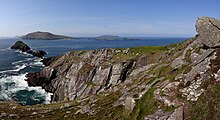Blasket Islands
Native name: Na Blascaodaí | |
|---|---|
 Blasket Islands as seen from Dunmore Head | |
 Location map of the Blasket Islands | |
| Geography | |
| Location | Atlantic Ocean |
| Total islands | 6 |
| Major islands | |
| Administration | |
| County | Kerry |
| Demographics | |
| Population | 0 (2011) |
The Blasket Islands (Na Blascaodaí in Irish) are an uninhabited group of islands off the west coast of Ireland, forming part of County Kerry. Abandoned in 1954 due to population decline, the islands are today best known from the story telling of Muiris Ó Súilleabháin and Peig Sayers, and former Taoiseach Charles Haughey's purchase of Inishvickillane in the 1980s.
History[]

The islands were inhabited until 1953 by a completely Irish-speaking population and today are part of the Gaeltacht. At its peak, the islands had 175 residents. The population declined to 22 by 1953. The government evacuated the remaining residents to the mainland on 17 November 1953 because of increasingly extreme weather that left the island cut off from emergency services.[1] The evacuation was seen as necessary by both the Islanders and the government.[2]
The islanders were the subject of much anthropological and linguistic study around the end of the 19th and beginning of the 20th centuries particularly from writers and linguists such as Robin Flower, George Derwent Thomson and Kenneth H. Jackson. Thanks to their encouragement and that of others, a number of books were written by islanders that record much of the islands' traditions and way of life. These include An tOileánach (The Islandman) by Tomás Ó Criomhthain, Peig by Peig Sayers and Fiche Blian ag Fás (Twenty Years A-Growing) by Muiris Ó Súilleabháin.
Geography[]
The six principal islands of the Blaskets are:
- Great Blasket Island (An Blascaod Mór)
- Beginish (Beiginis)
- Inishnabro (Inis na Bró)
- Inishvickillane (Inis Mhic Uileáin)
- Inishtooskert (Inis Tuaisceart)
- Tearaght Island (An Tiaracht)
Modern transport[]
There is a ferry service that calls only to the Great Blasket and sails from Dunquin.[3] This ferry service is mainly for day-trippers. People can also camp on the island overnight. Passengers are transferred to a RIB (rigid inflatable boat) once the ferry gets close to the island, as there are no adequate landing facilities for a larger vessel.[4]
References[]
- ^ Stagles, Joan and Ray, The Blasket Islands: Next Parish America. Dublin: O'Brien Press, 1980 (new edn. 1998).
- ^ Langan, Sheila (17 November 2018). "On This Day: The Blasket Islands evacuation of 1953". Irish Central. Retrieved 11 December 2018.
- ^ [1]
- ^ "Transshipping to the Great Blasket Island". Great Blasket Island. Retrieved 16 June 2021.
External links[]
| Wikimedia Commons has media related to Blasket Islands. |
- The Blascaod Centre in Dún Chaoin
- The last of the Blasket evacuees: ‘We weren’t great mixers on the mainland’
- Evacuation marks end of an era as last families leave the Blaskets
Coordinates: 52°05′21″N 10°32′49″W / 52.08917°N 10.54694°W
- Blasket Islands

